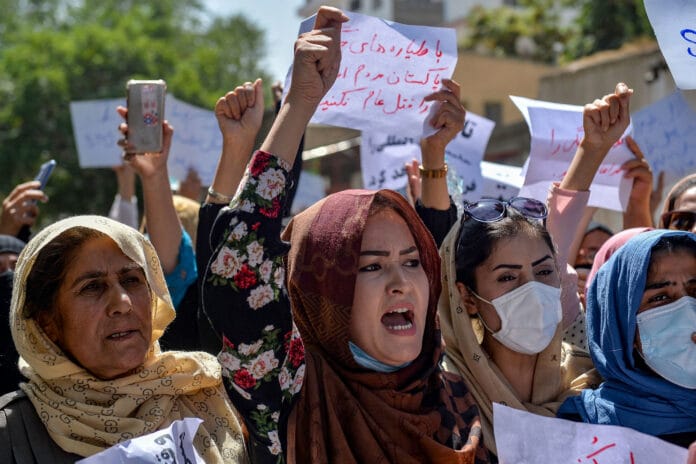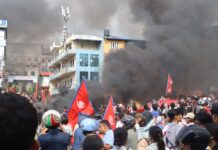
While the imperialist powers worry about the effects they will suffer, they ignore those of the Afghan people.
Rob Jones ISA
The twenty year occupation of Afghanistan by US and allied forces has been a disaster for those living in the country. At least a quarter of a million people, both combatants and civilians, have been killed, probably many more. Corruption is rife from the head of government down through the police, the army and courts. While the drug-rich warlords were kept on board by bribery, GDP per capita remained at less than $500 a year. Millions turned to drugs to escape reality. Whilst there have been some minor improvements in the position of urban women, those living in rural areas — the vast majority — face extreme poverty, threats of violence and war.
Now we see yet another in a long line of humiliating disasters for US imperialism — Korea, Vietnam, Somali, Syria, Libya and now Afghanistan. The pictures of thousands crowding Kabul airport, hundreds crowded into the hold of a US transport jet and harrowing pictures of those desperate to get out of the country falling off flying aircraft have graphically highlighted how serious a blow these events have been to the prestige of US imperialism. They ridicule Joe Biden’s words in early July, referring to the US’s forced evacuation from Saigon (Vietnam) in 1975, when he said “There’s going to be no circumstance where you see people being lifted off the roof of an embassy…”
This is not just a personal humiliation for Joe Biden, as he continues the foreign policy agenda of Donald Trump, but a huge blow to US interests. Launched as “Operation Enduring Freedom” in 2001 after the then Taliban government refused to give up the al-Queda group responsible for the attacks on the Twin Towers, and initially supported by a coalition of forty countries, the war has devoured huge human and monetary resources.
Over 100,000 Afghan troops, either pro government or pro-Taliban have lost their lives, while over 3,500 coalition soldiers and as many ‘contractors’ (privately hired combatants) have been killed. Tens of thousands of Afghan civilians have died.
At the same time, the US government has spent over $2.2 trillion on the war. Half of this has been consumed by the Department of Defense. Unbelievably $530 billion has gone to the banks as interest payments on the money borrowed to pay for the war. This latter figure towers over that spent to train the Afghan Defence Forces ($100 billion) or spent on infrastructure projects, usually paid to Western contractors and NGOs ($144 billion). The US will pay for this war in the form of compensation and pensions for veterans and continued interest charges for many years ahead.
Strategic competition
Biden has justified the sudden withdrawal saying that “American troops cannot and should not be fighting in a war and dying in a war that Afghan forces are not willing to fight for themselves.” Of course, many will have a certain sympathy with this statement, although US and UK veterans have already been vocal in their protests. One invalided bomb disposal expert tweeted: “Was it worth it, probably not. Did I lose my legs for nothing, looks like it. Did my mates die in vain. Yep. On my 11th Bangaversary it’s a very sombre one. Many emotions going through my head, anger, betrayal sadness to name a few …”
Despite his attempts to justify withdrawal in this way, the reality is that Biden is continuing the “strategic competition” approach of Trump, intended to clear the ground for an open battle with China. But the events in Kabul have, instead, weakened US imperialism’s hand and potentially strengthened the position of its main opponents in the region, in the first place China, but also Iran and Russia. They will certainly be emboldened in their actions now.
Already the Chinese regime, through its mouthpiece “Global Times” warns that “America’s abandonment of Afghanistan after 20 years was an ‘omen’ for Taiwan’s ‘future fate”. Although Premier Su Tseng-chang has responded by saying “Taiwan would not collapse like Afghanistan in the event of an attack” these events will fuel concerns that, in the event of a Chinese attack, the US would be unable or unwilling to come to the island’s assistance.
Why did the Ghani regime collapse so quickly?
The latest international leader to blame the Afghan government for this situation is NATO General Secretary Jens Stoltenberg who says that “Ultimately, the Afghan political leadership failed to stand up to the Taliban and to achieve the peaceful solution that Afghans desperately wanted”.
After twenty years and two trillion dollars the imperialist powers, including NATO which participated in the war until 2014, have failed to establish a stable regime capable of resisting the Taliban. The Pentagon insists that the Afghan Army and Police outnumbered the Taliban by 4 to 1. Yet it succumbed to the Taliban within days.
The US approach since the beginning has been built on illusions and wishful thinking that it could subjugate Afghanistan. In 2006 George W Bush’s Defense Secretary Donald Rumsfeld, the same one who authorized the use of torture against Afghan prisoners, claimed that a few years before “al-Qaida and the Taliban [had been] brutalizing the Afghan people. Today the terrorist training camps have been shut down, soccer stadiums are being used for soccer instead of executions … this is certainly a tribute to the people of Afghanistan.”
President Obama, with Joe Biden as Vice President, claimed that his ‘troop surge’, the tripling of US troops to 100,000 would end the war by 2014, when he was due to fight for his second term. The surge was wound down as parts of the Afghan defense forces started attacking the US troops instead — so called “insider attacks”.
Trump too, believing that the Taliban could be legitimized through negotiations in Doha, announced the troop withdrawal that has now been implemented by Biden. A picture had been painted in which the Afghan Defense force could hold back the Taliban. At worst, the US estimated, the Taliban advance would last months.
Afghan defense force — rotten to the core
Yet even the US Military’s West Point Academy estimated that the number of troops and police that the Pentagon claims is dramatically exaggerated, and moreover those troops that do exist are poorly trained. Corruption at the top is rife with the existence of many ‘ghost soldiers’ drawing pay to fill the pockets of the generals. Many soldiers are illiterate, and about 25% desert every year. In this situation the Pentagon’s approach of equipping the army with high tech drones and supporting actions against the Taliban with airstrikes could not be maintained after the US troops withdrew. In May, US Defense Secretary Lloyd Austin promised continued support for air operations using ‘zoom conferencing’ — a ludicrous idea in a country in which the internet barely operates. As if this was not enough, most defense force staff were paid from the Pentagon budget until recently, now many have been left without pay. It is not surprising they put up so little resistance.
The fact that Ashraf Ghani, President fled Afghanistan so quickly without even attempting to resist the Taliban is a reflection of the complete lack of a social base for his regime. The last Presidential election was very controversial. Although Ghani won a majority of votes, turnout was under 20%. According to Ghani himself, 90% of Afghans have an income of less than $2 a day. Only 43% are literate, whilst 55% lack clean water and 31% sanitation. The country’s GDP is $20 billion, a figure that is miniscule compared to the sums spent by the US over 20 years. If instead imperialism had assisted in developing a proper economy, many of those engaged in the drugs trade or smuggling (Afghanistan’s main sources of foreign trade) or who support the Taliban for economic reasons could now be engaged in socially useful work, and fundamentalism could have been deprived of a base.
For a short period, it appeared that some of the local warlords, who make huge profits out of the opium trade and other illegal actions, believing that the Defense Force was going to make a stand, were preparing to oppose the Taliban. Three of the most influential warlords — Atta Muhammad Noor, Abdul Rashid Dostum and Haji Muhammad Muhaqiq — met to forge a joint front with the army. But as the cities rapidly fell to the Taliban, they abandoned the struggle and fled abroad. Other warlords, of course, will have temporarily accepted their fate and fallen in line with the Taliban.
Response of the imperialist powers
The humiliating defeat for US imperialism has, of course, met with a response from Biden trying to avoid blame in a televised broadcast. They and other imperialist powers such as Canada, Germany, Australia, and the UK are evacuating as rapidly as possible their citizens, and some of those Afghans who have worked for them as translators or in other capacities from the besieged Kabul airport. Iran, China, Russia and of course Pakistan are maintaining their embassies.
Almost in unison, the different powers say they will wait to see whether they will recognize the Taliban government. Boris Johnson, speaking before an extremely fractious emergency parliamentary debate said that “the legitimacy of any future Taliban government will be subject to them upholding internationally agreed standards on human rights and inclusivity.” But the Western imperialists have, at the moment, few levers left to exert pressure on the new government to ensure that such standards are met.
The non-western imperialist powers China, Russia, Iran, have been remarkably strengthened by these events. China was quick to gloat about the US defeat — the Xinhua News Agency called it “the death knell for declining U.S. hegemony” in which “the sound of roaring planes and the hastily retreating crowds mirrored the last twilight of the empire”. But these powers still view the situation as one offering both threats and opportunities.
Chinese Foreign Ministry spokesman Zhao Lijian, for example, says that China will extend diplomatic recognition to the Taliban only after the formation of the government, which should be “open, inclusive and broadly representative”.
Facing the threat of a wave of refugees, China quickly moved to strengthen its 70 kilometer border between Xinjiang province and Afghanistan. It fears, in particular, that the Taliban victory will boost the position of the Muslim Uighurs, and is insisting from the Taliban that it moves to restrict the activities of the ethnic Uighur ‘East Turkistan Islamic Movement’ and other groups.
In recent negotiations with the Taliban, China has raised the possibility of big “Belt and Road Initiative” (BRI) projects if these groups are reigned in. Such projects only make sense however, if they enable China to extend their corridor through Pakistan. BRI initiatives there though appear to have stalled due to local opposition including terrorist attacks against Chinese workers, and the possible default by Islamabad of the repayment of debts associated with the BRI.
The Chinese already have a history in Afghanistan. Even under US occupation, China has been the country’s biggest investor, in part because of the relative stability. It is estimated that there are proven deposits of Iron, Copper, Talcum and Lithium worth over $1trillion. The latter, in particular, is a key for the production of electric vehicles, Afghanistan has even been called the ‘Saudi Arabia of Lithium”. Though the two governments signed a deal to mine copper way back in 2007, the project has stalled.
Not only will any future investment depend on whether the Taliban can assure stability across the country, but also on the situation in Pakistan, where the Taliban victory will strengthen the position of Islamic groups opposed to China. It is for these reasons that China, like Iran, is keen to see negotiations between the Taliban and other groups to form an ‘inclusive government’.
Russia does not have the same economic strength as China, but it does have a powerful military, and has a security agreement with Tajikistan and Uzbekistan — both having long borders with Afghanistan. Turkmenistan, the ‘North Korea’ of Central Asia will have to look after its own borders, whilst Turkey is reportedly strengthening a wall on its border to repel refugees.
Russia’s Foreign Ministry is displaying its usual cynical hypocrisy. The Russian Ambassador in Kabul even commented, as the Taliban were taking over, that it “is taking control of the city in the positive sense of the words. It is maintaining law and order”. Now Taliban fighters are protecting the Russian Embassy in Kabul.
But since the Taliban sent fighters and support to Chechen militants in 1999, the Taliban has been deemed a terrorist organization in Russia. This did not prevent them sending a delegation to discuss with the Russian government in July. Russia too wants to see, in the words of Foreign Minister Sergey Lavrov “a government with the participation of other political forces” with the “beginning of an all-inclusive dialogue with the participation of all political and ethnic groups”. It too is seeking guarantees that extremist groups are prevented from infiltrating into Central Asia and stability to prevent massive waves of refugees. Russia has already sent 7,000 troops to boost the Tajik border, concerned by the information that Tajik militants who fought with the Taliban are now responsible for patrolling the other side of the border in NE Badakhshan.
False comparisons
It is understandable that many have drawn comparisons with the US’s retreat from Saigon in 1975. Even this article has done so! But the situation then, at the height of the first ‘Cold War’, was completely different. Then the Cold War was between two competing political and economic systems — capitalist imperialism and the non-capitalist Stalinist bloc. The war in Vietnam represented the strivings of a former colonial people to break away from capitalism, and the victory based on mass peasant struggle, land reform and the introduction of elements of a planned economy was a victory for the international workers movement. The defeat of US Imperialism now, however, has not only strengthened the other capitalist-imperialist power — China, it has seen a reactionary, religious and practically feudal force come to power.
Others have also looked back to the previous ‘humiliating retreat’ from Afghanistan, that of the Soviet Union in 1989. The Chinese regime has even gloated, this week, that Afghanistan is the “Graveyard of empires”, although of course the USSR was not an empire in the Marxist sense of the word.
The Soviet retreat took place in the context of the rapidly developing collapse of the Stalinist bloc. The initial invasion of Afghanistan in 1979 by the Brezhnev regime, ostensibly at the “invitation of the Afghan government” gave the Western imperialists a propaganda weapon. Nevertheless, Soviet troops helped to prop up the Najibullah regime, the land reforms and partial improvements in health care and education, with women having at least formal equality. Their withdrawal led to the collapse of the regime three years later. But it was US imperialism’s support at that time for the mujahideen, including through Osama bin Laden, by providing weapons and resources to fight the Soviet troops that is responsible for the rise of the Taliban, the Frankenstein monster of imperialism’s cold war strategy.
So, has the Taliban now changed?
Civil war followed the collapse of the Najibullah government as the different groups fought each other. The Taliban developed out of these mujahideen groups with the backing of Pakistan. Many were trained in Saudi Arabia’s fundamentalist madrassas. In 1996 they captured Kabul. Their regime banned all opposition groups, political parties and trade unions, virtually enslaved women, stopped education for girls, prevented women from working and prohibited music, sports and games. Transgressors of Taliban Sharia law were ruthlessly dealt with. Adultery by women was punishable by stoning to death, homosexuals buried alive. A UN funded football stadium in Kabul was used to stage public executions.
There is now discussion about whether the Taliban has changed from what it was twenty years ago. Time of course will tell. There are indications that it will be forced to soften its approach. In the 1990s supporters were not even allowed to use telephones, now militants in Kabul are seen taking selfies and using twitter. On a more fundamental level the leading figures are assuring that women’s rights will be respected and there will be a free press, within, of course, the “rules of Islam”. They claim there will be an amnesty for those who served the previous regime. There are though already many examples where women have been suspended from work or made to wear the hijab.
The Taliban remains a fundamentally rural based organization. In the last twenty years there has been an increase in urbanization of the country — Kabul has grown from 1.5 to 4 million residents. The number of city dwellers has grown from 2.6 to 10 million. Moreover, 46% of the population are under 15 years old. It is likely, therefore, that tensions will grow within the Taliban, which up till now has been united fighting a common enemy, between those based on the backward, fundamentalist rural regions and the more open urban areas. The existence of other fundamentalist groups will exacerbate this situation. It is, however, also possible that as the Taliban meets growing opposition in the cities it will retreat to its former methods.
Can the Taliban establish a stable government?
The previous Taliban government held power from 1996 to 2001, when it was overthrown by the US invasion. During that period it never controlled the whole country, meeting significant opposition particularly from the Northern Alliance, supported at that time by Iran, India and Russia. It is already meeting some resistance with anti-Taliban protests attracting thousands of residents in Jalalabad and maybe too in Khost province. There are also reports of attempts to pull together a “Northern Alliance 2.0” in the Panjshir valley.
But new forces have also emerged in Afghanistan. Women, who have had some freedoms in the last decade or so, with solidarity from the global womens’ movement, are not likely to merely accept new restrictions. The young population too, with its international outlook and modern communications can add their protests. The workers’ movement is not strong, as industry is weak, but it does exist, and indeed the main trade union body met repression from the Ghani regime.
As it tries to establish its rule, the Taliban is likely to meet many difficulties. Will the warlords maintain their passive support? Will the Taliban itself remain united? Will other powers such as Iran, Russia and China through their interventions support different interests? Russia is already reportedly discussing with some warlords.
At the same time, there are serious crises looming in Afghanistan itself. A third wave of Covid is thought to be sweeping the country, ‘thought to be’ because there is no serious testing infrastructure. One survey suggests that over 40% are now infected. Yet hospitals have no resources to deal with this. One doctor says they can only barely treat one third of those who are ill.
After suffering severe drought in 2018, one farmer commented “The sky has stopped raining on us, the earth has stopped growing grass for us”. The next few months are expected to be even worse with 12 million Afghans, one third of the population expected to face “Emergency levels of food insecurity”.
The Taliban faces huge tests in the next few months, to tackle these problems as well as the economic collapse, refugee flows, cross border tensions and the continued drug trade.
Is there a way out?
One thing only is clear. The imperialist intervention was a catastrophe. Taliban rule, if allowed to continue, will be a nightmare. By restricting the measures it took to modernize society, and the top-down undemocratic way in which they were implemented, the Soviet-backed Najibullah government failed to transform Afghan society. All the fundamental problems of society, impoverishment, the lack of democratic rights, national oppression, religious fundamentalism and social repression remain, and cannot be solved on the basis of capitalism.
What is needed is the building of a mass movement in opposition to the Taliban and imperialism, uniting the working class, poor farmers, women, youth in a struggle to establish a democratic workers and poor farmers government. This of course can only succeed if done as part of an international struggle involving the working class of other countries in the region that could open the way for creating a genuine, democratic and voluntary socialist federation in the region.



